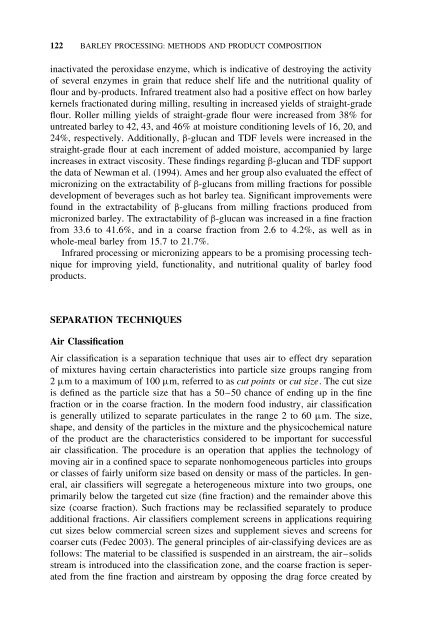Barley for Food and Health: Science, Technology, and Products
Barley for Food and Health: Science, Technology, and Products
Barley for Food and Health: Science, Technology, and Products
You also want an ePaper? Increase the reach of your titles
YUMPU automatically turns print PDFs into web optimized ePapers that Google loves.
122 BARLEY PROCESSING: METHODS AND PRODUCT COMPOSITION<br />
inactivated the peroxidase enzyme, which is indicative of destroying the activity<br />
of several enzymes in grain that reduce shelf life <strong>and</strong> the nutritional quality of<br />
flour <strong>and</strong> by-products. Infrared treatment also had a positive effect on how barley<br />
kernels fractionated during milling, resulting in increased yields of straight-grade<br />
flour. Roller milling yields of straight-grade flour were increased from 38% <strong>for</strong><br />
untreated barley to 42, 43, <strong>and</strong> 46% at moisture conditioning levels of 16, 20, <strong>and</strong><br />
24%, respectively. Additionally, β-glucan <strong>and</strong> TDF levels were increased in the<br />
straight-grade flour at each increment of added moisture, accompanied by large<br />
increases in extract viscosity. These findings regarding β-glucan <strong>and</strong> TDF support<br />
the data of Newman et al. (1994). Ames <strong>and</strong> her group also evaluated the effect of<br />
micronizing on the extractability of β-glucans from milling fractions <strong>for</strong> possible<br />
development of beverages such as hot barley tea. Significant improvements were<br />
found in the extractability of β-glucans from milling fractions produced from<br />
micronized barley. The extractability of β-glucan was increased in a fine fraction<br />
from 33.6 to 41.6%, <strong>and</strong> in a coarse fraction from 2.6 to 4.2%, as well as in<br />
whole-meal barley from 15.7 to 21.7%.<br />
Infrared processing or micronizing appears to be a promising processing technique<br />
<strong>for</strong> improving yield, functionality, <strong>and</strong> nutritional quality of barley food<br />
products.<br />
SEPARATION TECHNIQUES<br />
Air Classification<br />
Air classification is a separation technique that uses air to effect dry separation<br />
of mixtures having certain characteristics into particle size groups ranging from<br />
2 μm to a maximum of 100 μm, referred to as cut points or cut size. Thecutsize<br />
is defined as the particle size that has a 50–50 chance of ending up in the fine<br />
fraction or in the coarse fraction. In the modern food industry, air classification<br />
is generally utilized to separate particulates in the range 2 to 60 μm. The size,<br />
shape, <strong>and</strong> density of the particles in the mixture <strong>and</strong> the physicochemical nature<br />
of the product are the characteristics considered to be important <strong>for</strong> successful<br />
air classification. The procedure is an operation that applies the technology of<br />
moving air in a confined space to separate nonhomogeneous particles into groups<br />
or classes of fairly uni<strong>for</strong>m size based on density or mass of the particles. In general,<br />
air classifiers will segregate a heterogeneous mixture into two groups, one<br />
primarily below the targeted cut size (fine fraction) <strong>and</strong> the remainder above this<br />
size (coarse fraction). Such fractions may be reclassified separately to produce<br />
additional fractions. Air classifiers complement screens in applications requiring<br />
cut sizes below commercial screen sizes <strong>and</strong> supplement sieves <strong>and</strong> screens <strong>for</strong><br />
coarser cuts (Fedec 2003). The general principles of air-classifying devices are as<br />
follows: The material to be classified is suspended in an airstream, the air–solids<br />
stream is introduced into the classification zone, <strong>and</strong> the coarse fraction is seperated<br />
from the fine fraction <strong>and</strong> airstream by opposing the drag <strong>for</strong>ce created by

















